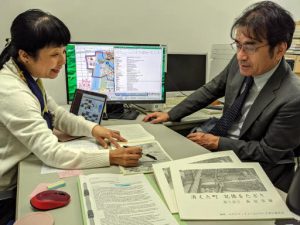Citizens’ group hopes to give Pope book of drawings that depict cityscape of Hiroshima prior to A-bomb destruction
Nov. 16, 2019
by Junji Akechi, Staff Writer
In anticipation of the visit to Hiroshima by Pope Francis, the Hiroshima Fieldwork Committee, a citizens’ group, has been working on an English translation of a book titled Kieta machi: Kioku o tadori (Vanished Neighborhood: Retracing Memories). The book is a collection of pencil drawings that faithfully depict the former cityscape of Hiroshima, which was destroyed by the atomic bombing. The group is hoping to give the book to the Pope so that the drawings can enable people around the world to understand that there were once streets and houses in what is now the Hiroshima Peace Memorial Park, and that people led ordinary lives there. They are now wondering how to present the book to the Pope, who will visit Hiroshima on November 24.
The A4-size book, which consists of 88 pages, features 43 drawings by Shigeo Moritomi, 90, based on his memories from before the atomic bombing. Mr. Moritomi, an A-bomb survivor living in Nishi Ward, Hiroshima, grew up in the present-day Otemachi area in the central part of Hiroshima and lost five family members because of the bombing. The drawings depict the streets in detail, even each shop, in the neighborhood around the hypocenter, including the Hiroshima Commercial Exhibition Hall, which is now the Atomic Bomb Dome. Captions explain that children swam in the Motoyasu River and describe how people lived during Mr. Moritomi’s childhood. The book was published by the citizens’ group in 2011 and was republished in 2018.
This past summer, Mikio Nakagawa, 61, the president of the group, suggested that the book be translated into English. He felt that, in spite of the growing number of international visitors to the park, many people are still unaware of the fact that people once led their lives in this area that was annihilated by the bomb.
Luli van der Does, an associate professor at the Center for Peace of Hiroshima University has been working on the translation. She interviewed former residents of the area and conducted field surveys in her spare time over a period of three months. She said, “The drawings vividly depict the day-to-day lives of the children.” According to her, an American proofreader told her that the book brought the full realization, for the first time, of how the atomic bomb destroyed the lives of the people on the ground.
It is not certain when the translated version of the book will be completed, but the group hopes to give the book to the Pope when he visits Hiroshima and delivers a message from the park on November 24. Mr. Nakagawa said, “The Pope can convey strong messages to the world, so we hope that he will learn about how people once lived in this place, where he will stand and speak.”
(Originally published on November 16, 2019)
In anticipation of the visit to Hiroshima by Pope Francis, the Hiroshima Fieldwork Committee, a citizens’ group, has been working on an English translation of a book titled Kieta machi: Kioku o tadori (Vanished Neighborhood: Retracing Memories). The book is a collection of pencil drawings that faithfully depict the former cityscape of Hiroshima, which was destroyed by the atomic bombing. The group is hoping to give the book to the Pope so that the drawings can enable people around the world to understand that there were once streets and houses in what is now the Hiroshima Peace Memorial Park, and that people led ordinary lives there. They are now wondering how to present the book to the Pope, who will visit Hiroshima on November 24.
The A4-size book, which consists of 88 pages, features 43 drawings by Shigeo Moritomi, 90, based on his memories from before the atomic bombing. Mr. Moritomi, an A-bomb survivor living in Nishi Ward, Hiroshima, grew up in the present-day Otemachi area in the central part of Hiroshima and lost five family members because of the bombing. The drawings depict the streets in detail, even each shop, in the neighborhood around the hypocenter, including the Hiroshima Commercial Exhibition Hall, which is now the Atomic Bomb Dome. Captions explain that children swam in the Motoyasu River and describe how people lived during Mr. Moritomi’s childhood. The book was published by the citizens’ group in 2011 and was republished in 2018.
This past summer, Mikio Nakagawa, 61, the president of the group, suggested that the book be translated into English. He felt that, in spite of the growing number of international visitors to the park, many people are still unaware of the fact that people once led their lives in this area that was annihilated by the bomb.
Luli van der Does, an associate professor at the Center for Peace of Hiroshima University has been working on the translation. She interviewed former residents of the area and conducted field surveys in her spare time over a period of three months. She said, “The drawings vividly depict the day-to-day lives of the children.” According to her, an American proofreader told her that the book brought the full realization, for the first time, of how the atomic bomb destroyed the lives of the people on the ground.
It is not certain when the translated version of the book will be completed, but the group hopes to give the book to the Pope when he visits Hiroshima and delivers a message from the park on November 24. Mr. Nakagawa said, “The Pope can convey strong messages to the world, so we hope that he will learn about how people once lived in this place, where he will stand and speak.”
(Originally published on November 16, 2019)








